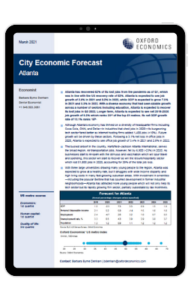US | City Economic Forecast: Atlanta

Atlanta has recovered 52% of its lost jobs from the pandemic as of Q1, which was in line with the US recovery rate of 52%. Atlanta is expected to see job growth of 2.6% in 2021 and 3.2% in 2022, while GDP is expected to grow 7.3% in 2021 and 3.3% in 2022. With a diverse economy that had seen sizable growth across a number of sectors including education, Atlanta is expected to recover its lost jobs in Q3 2022. Longer term, Atlanta is expected to see net 2019-2025 job growth of 3.2% which ranks 23rd of the top 51 metros. Its net GDP growth rate of 13.1% ranks 15th.
What you will learn:
- Although Atlanta’s economy has thrived on a diversity of headquarter firms including Coca Cola, CNN, and Delta—in industries that shed jobs in 2020—its burgeoning tech sector fared better as internet hosting firms added 1,400 jobs (+10%).
- The busiest airport in the country, Hartsfield–Jackson Atlanta International, serves the broad region. Air transportation jobs, however, fell by 6,900 (-23%) in 2020.
- With three large universities drawing many young people to the region, Atlanta was expected to grow at a healthy rate, but it struggles with wide income disparity and high living costs in many fast-growing suburban areas.
Tags:
Related Services

Post
UK: Supply constraints are probably less prominent in the south
The extent to which UK employers can respond to likely 2024 interest rate cuts with increased output, rather than rises in prices and wages, will partly reflect the extent of spare capacity. This will inevitably vary by region. Evidence on this is imperfect, but in terms of capital assets (including intangibles) and labour availability, southern regions appear to be in a stronger position than those in the UK's traditional industrial heartland.
Find Out More
Post
Global Private equity real estate fund maturities spur asset sales
We expect the significant increases in fund maturities, spurred by capital raised over the past decade, to exert upward pressure on the rate of asset disposals as the funds approach the end of their lifecycles.
Find Out More